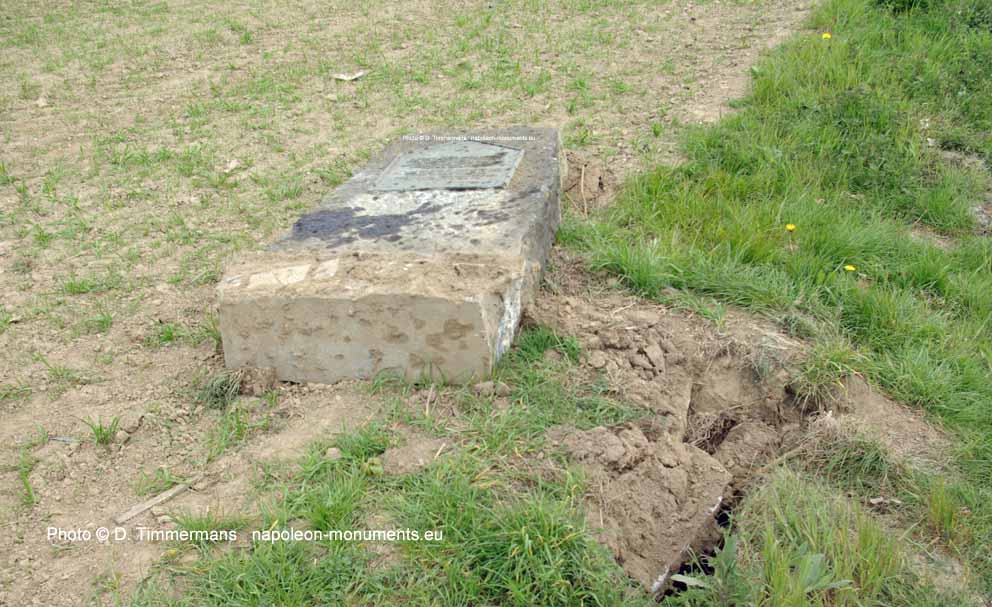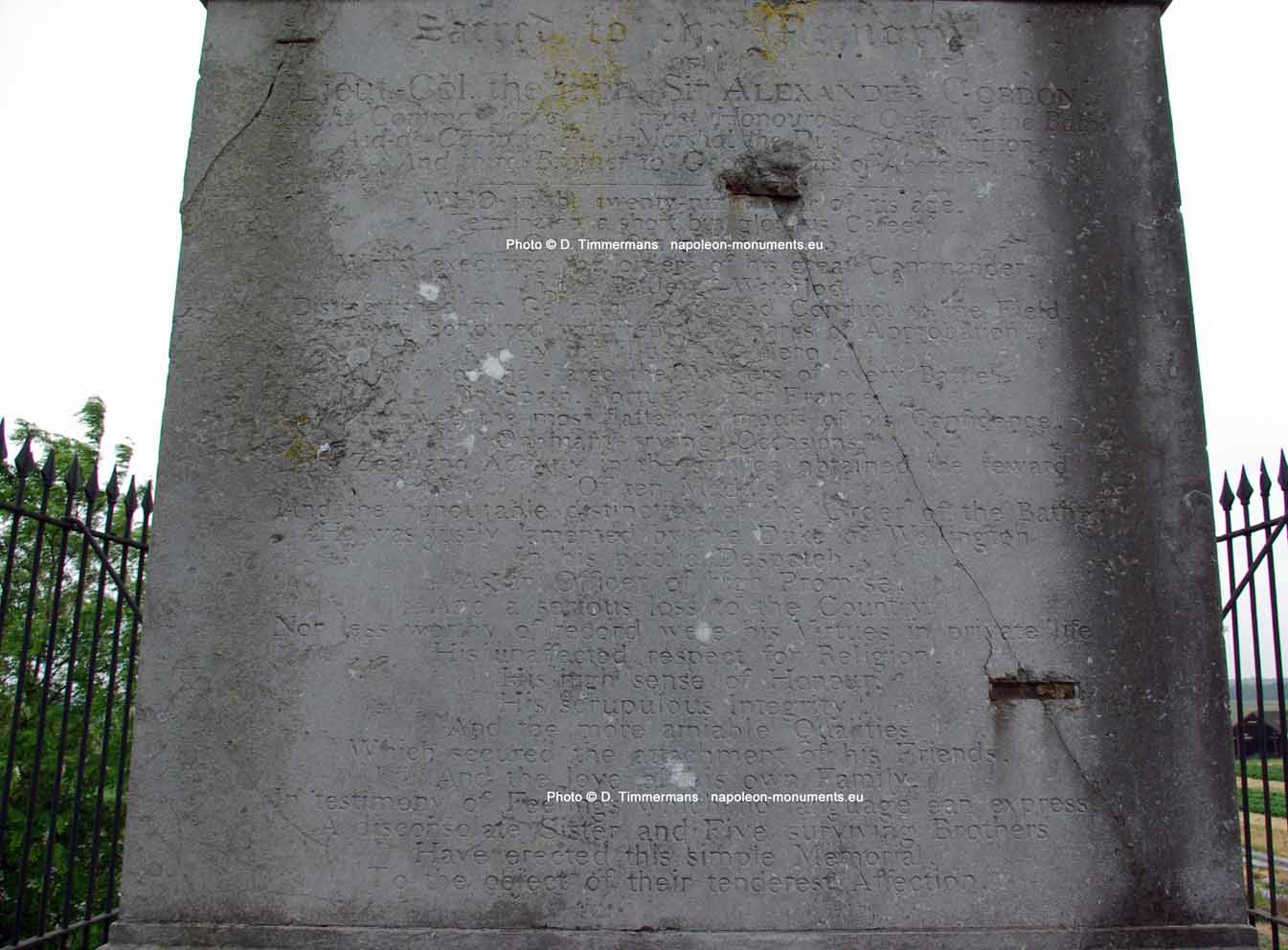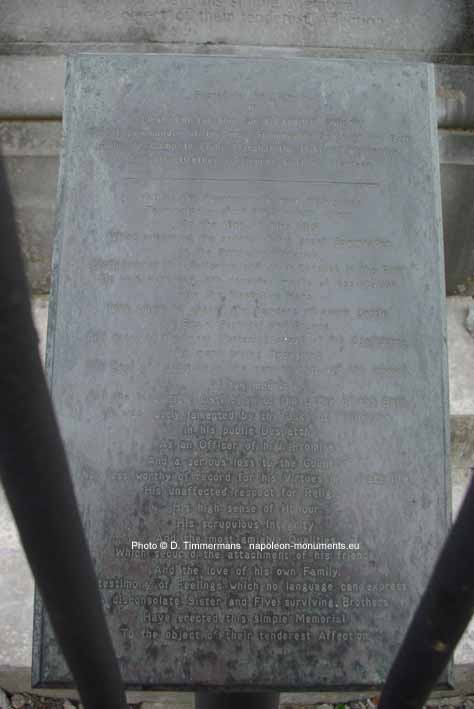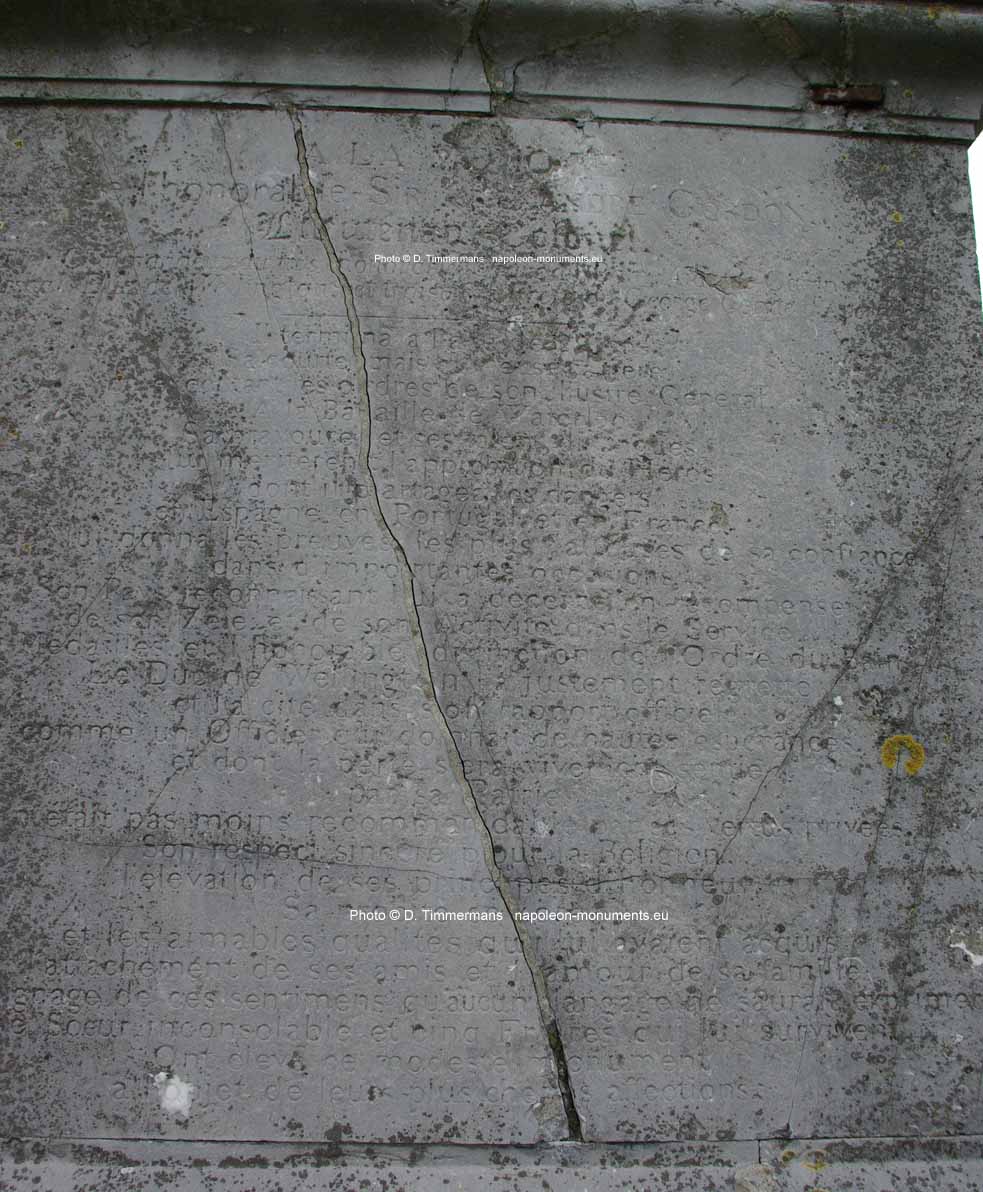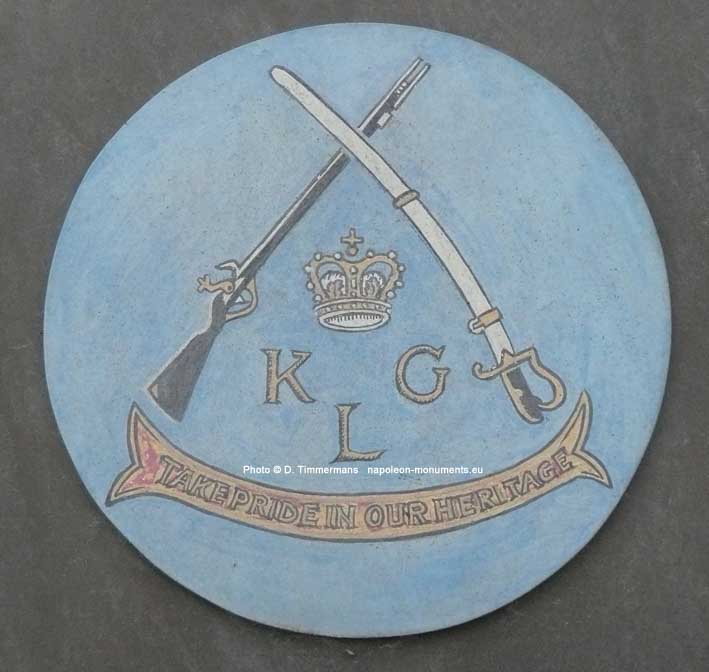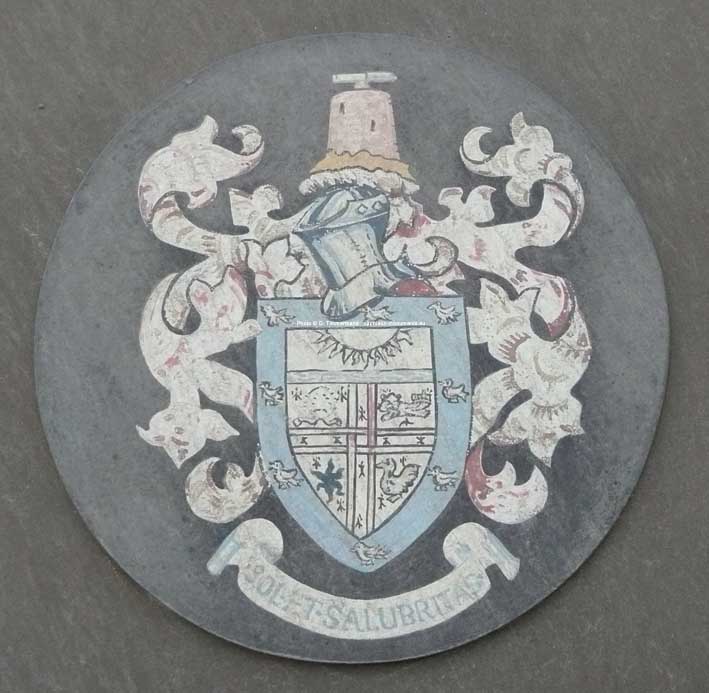18th
JunE 1815
THE BRITISH MONUMENTS
Contrary to popular believe, they are not so
numerous. The heart of the British line is now unfortunately occupied by the
Lion hamlet, this might be the reason.
Beware : we shall treat here only the British on
the battlefield of the 18th of June (with the exception of the
Hougoumont area, which is treated on a separate page). Neither shall we speak here
about the La Cambre wood stele, the Quatre-Bras monument, those in the
Waterloo church or
the Evere cemetery memorial. The numbers on the map are clickable.
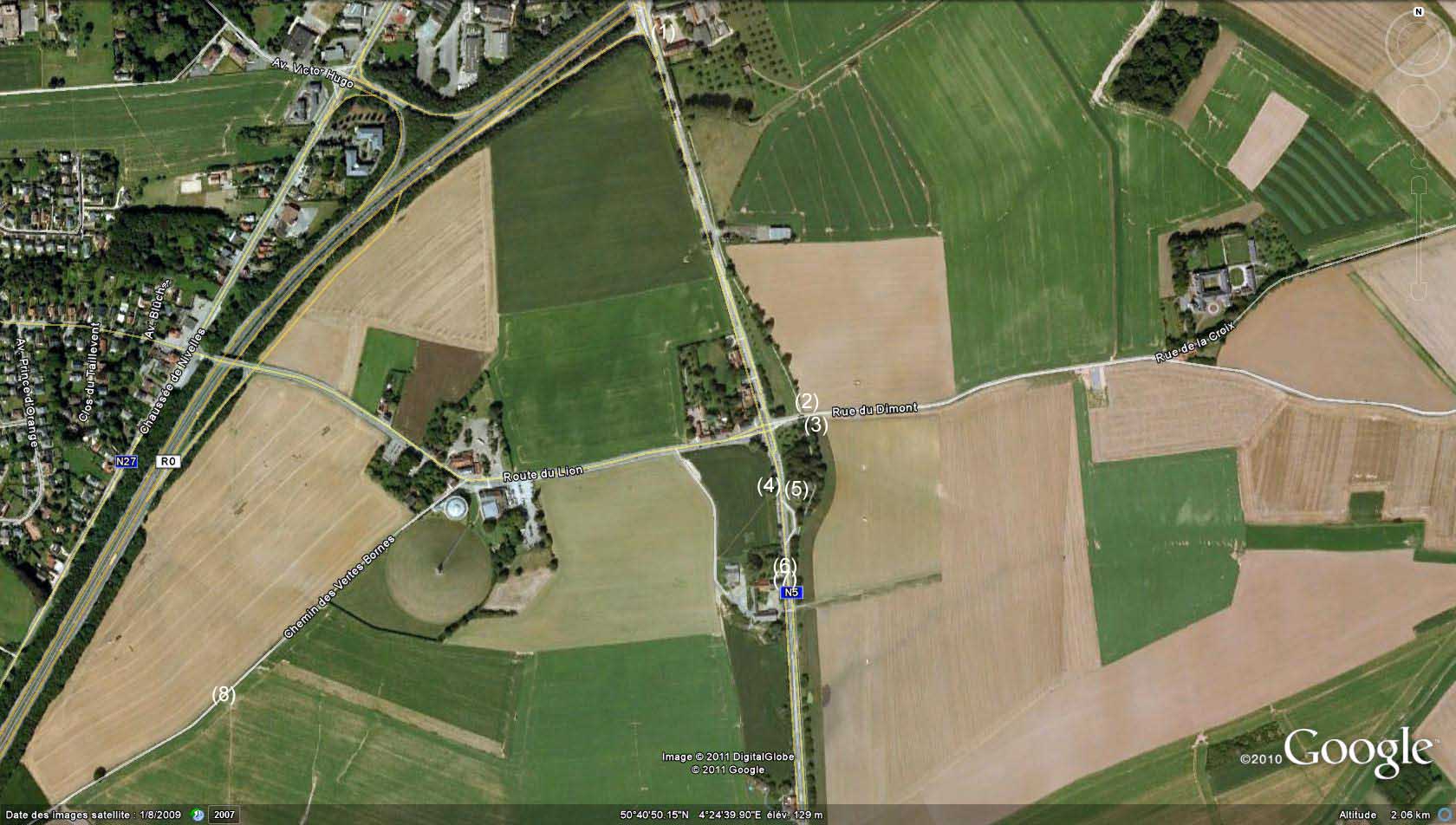
1) Commemorative plate to Deputy Inspector Gunning and to
the British Army Medical Services (Mont-Saint-Jean farm)
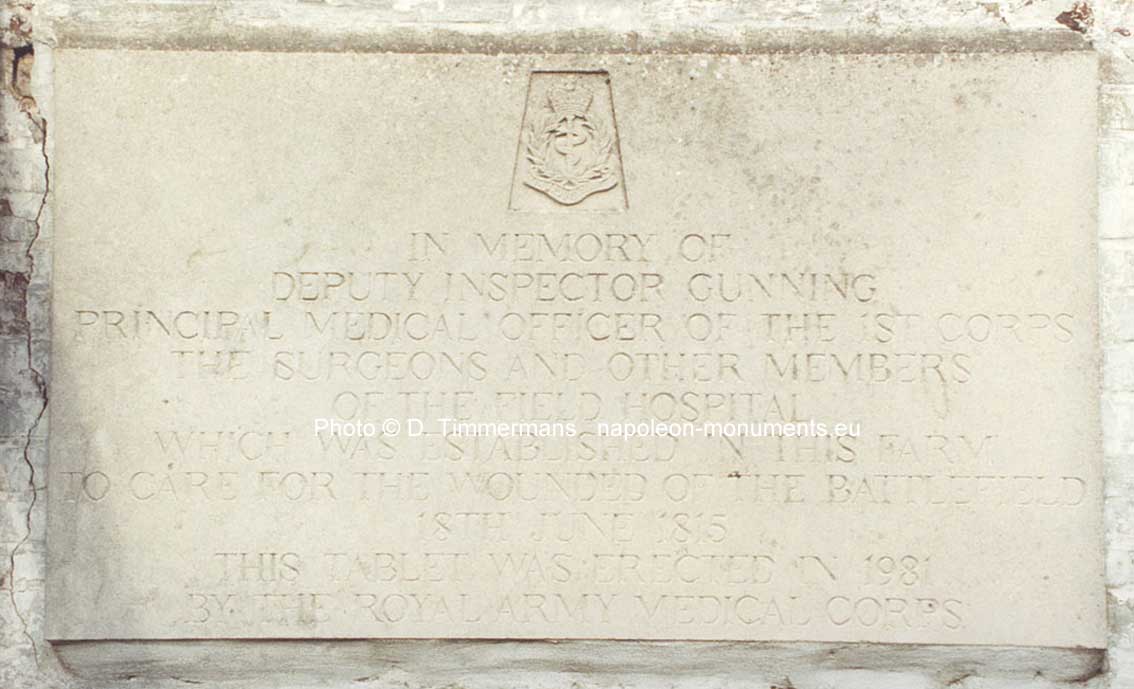 |
IN MEMORY OF
DEPUTY INSPECTOR GUNNING
PRINCIPAL MEDICAL OFFICER OF THE 1ST CORPS
THE SURGEONS AND OTHERS MEMBERS
OF THE FIELD HOSPITAL
WHICH WAS ESTABLISHED IN THIS FARM
TO CARE FOR THE WOUNDED OF THE BATTLEFIELD
18TH JUNE 1815
THIS TABLET WAS ERECTED IN 1981
BY THE ROYAL ARMY MEDICAL CORPS |
After having taken part in the Flanders campaign of 1793, John Gunning
had been appointed Staff Surgeon on the 1st of September 1803 and Deputy Inspector of
Hospitals on 17 September 1812. During the Peninsular war, he had been
present at Vimeiro, Talavera, Bussaco, Fuentes, Ciudad Rodrigo, Badajoz,
Salamanca, Vitoria, San Sebastian and Orthez. He later became Deputy
Inspector General and the King's Surgeon. He died in 1863 in Paris and was
buried at the Montmartre cemetery (32nd division (avenue Saint-Charles, opposite
Thiard in the 15th division) !
Mont-Saint-Jean farm, a former Templar's commander's residence. The
building is listed, and that's how it looked like in 1971.
This farm is all that remains of the hamlet of Mont-Saint-Jean, more to
the North.
|
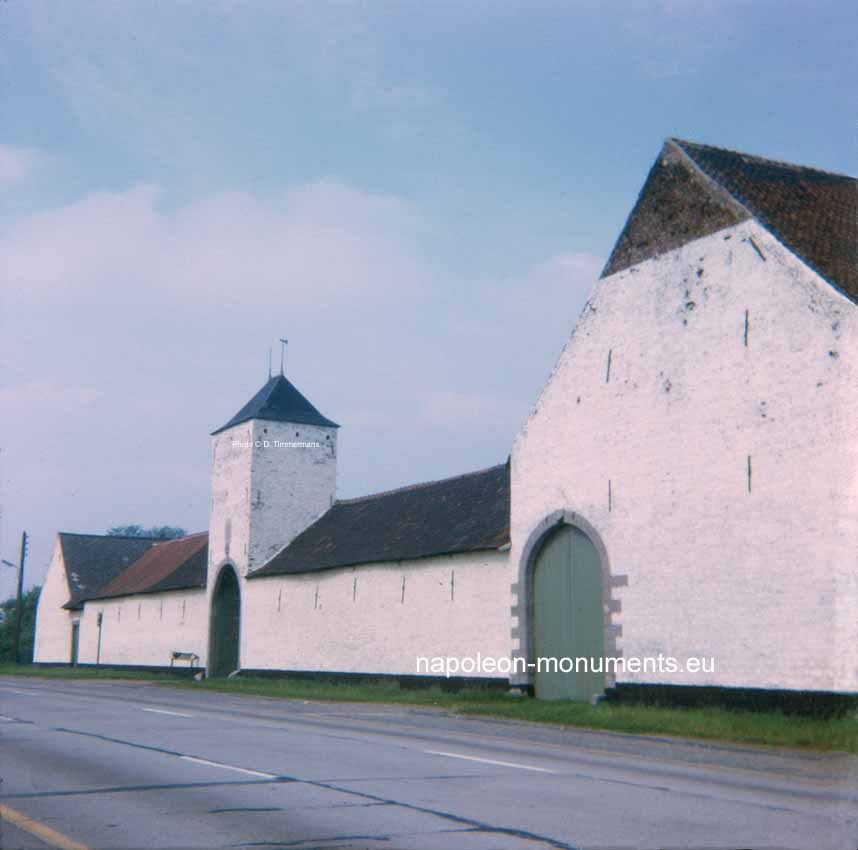 |
And this is how it looked like in 2007, after the collapse of the pigeon
house above the entrance. This happened in the early nineties.
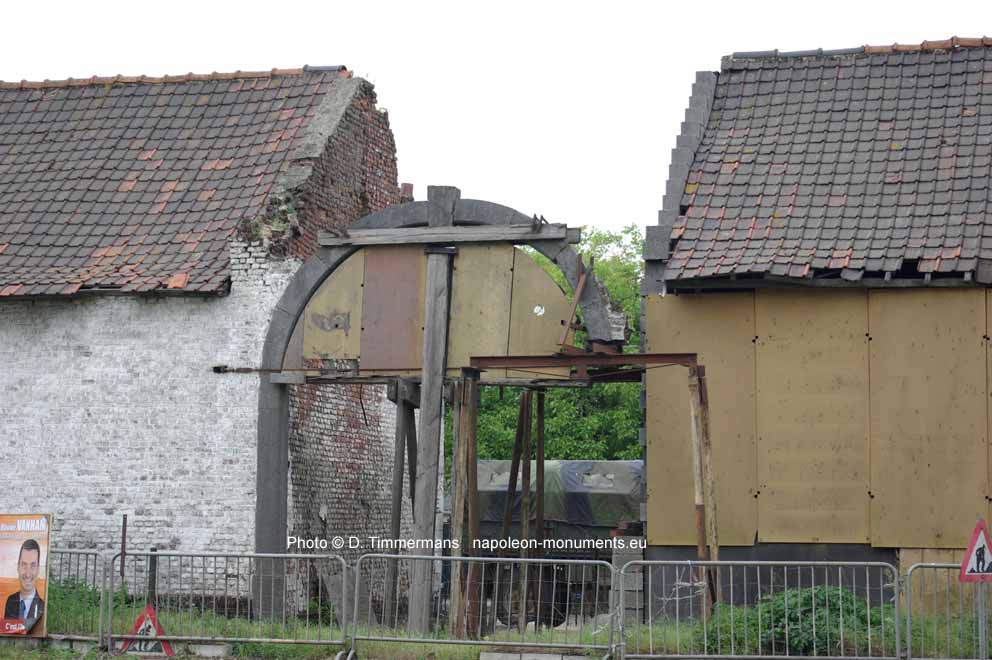
In 2011, the plate has disappeared in the bushes.
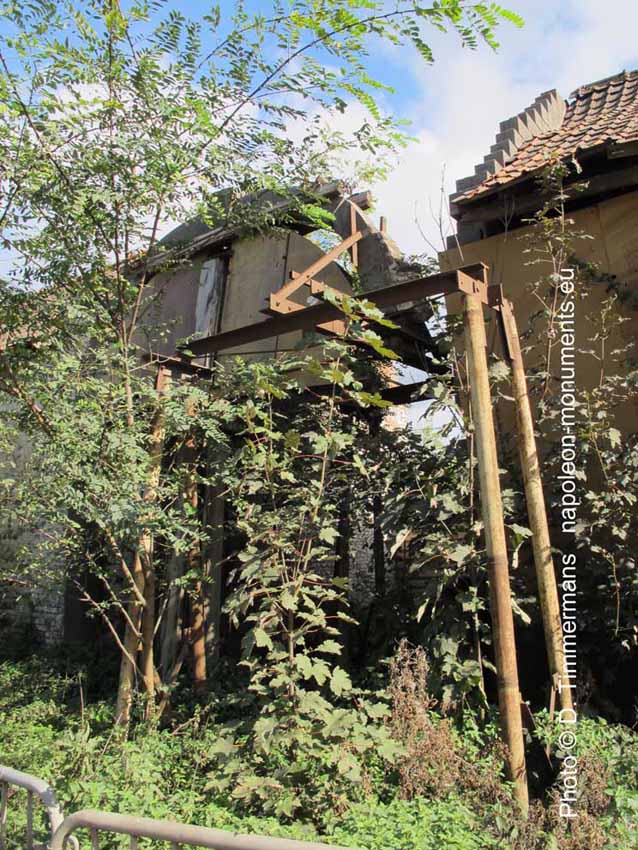
March 2012 : works have started
The restauration works to the façade and to the pigeon house
above the entrance are advancing.
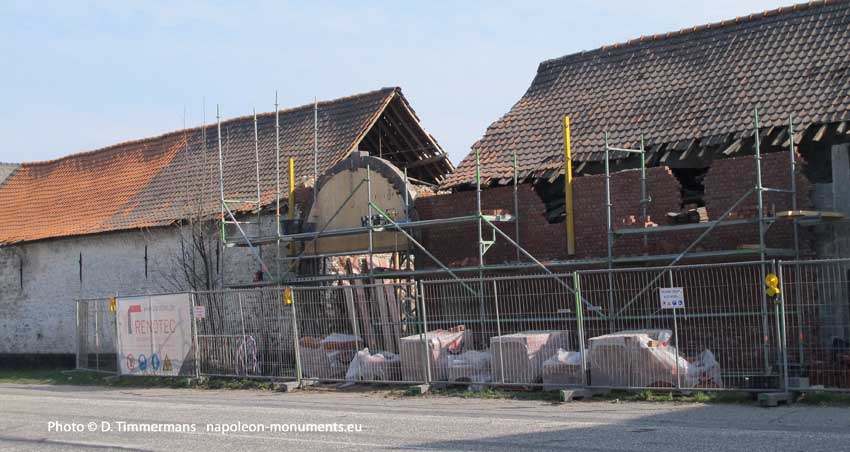
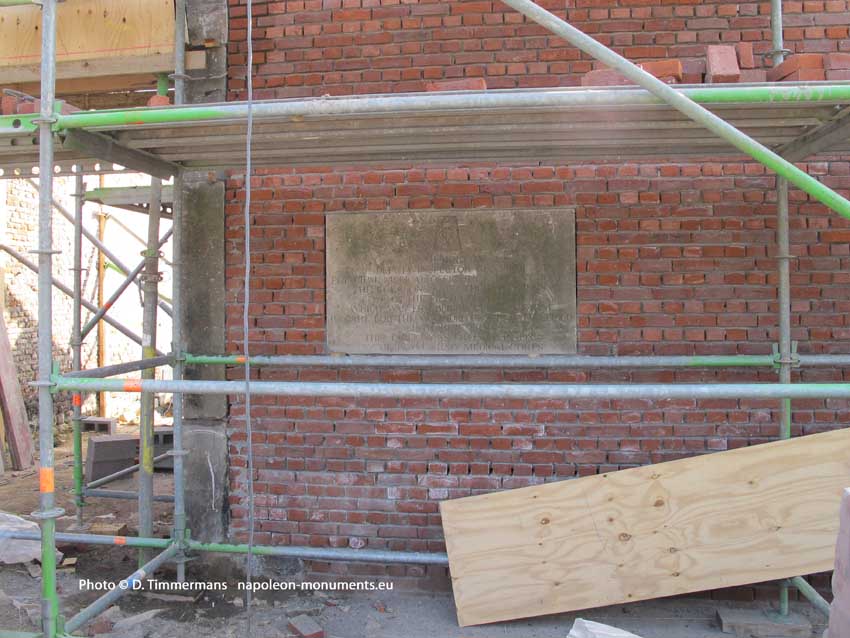 |
The commemorative plaque to the British Army Medical Services has
already been put back in place.
|
2) Stele to the 27th (Inniskilling) Regiment
of Foot
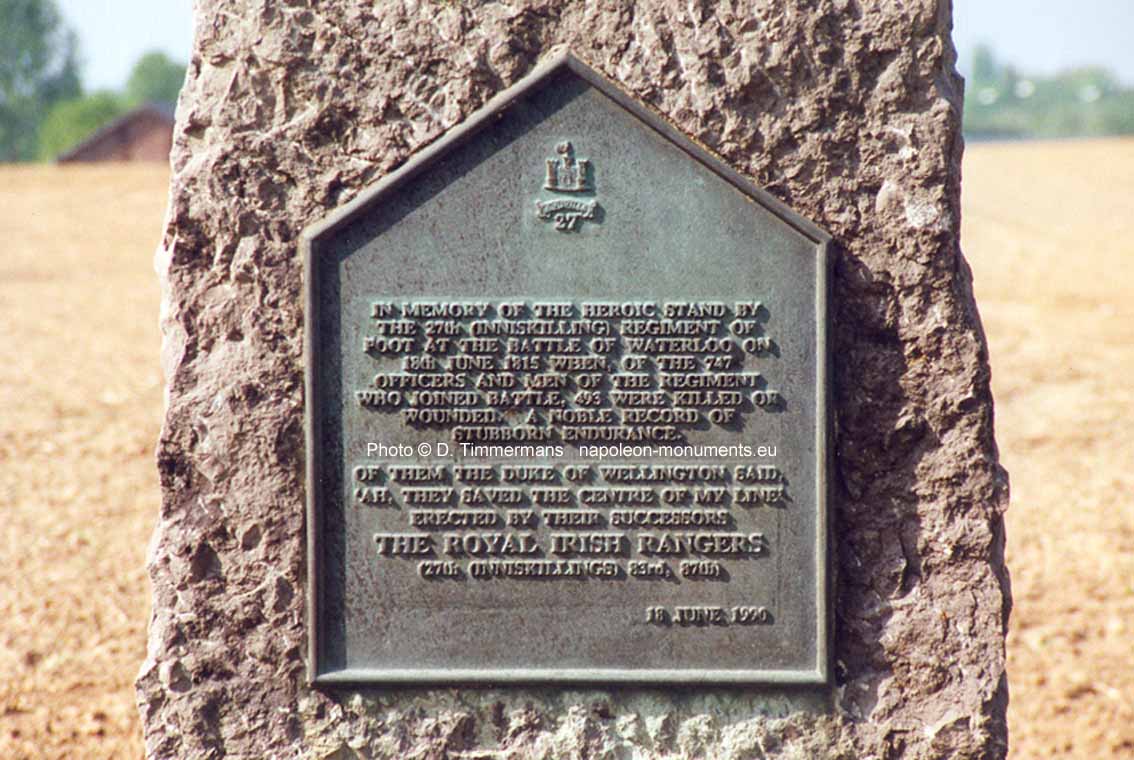 |
IN MEMORY OF THE HEROIC STAND BY
THE 27th (INNISKILLING)
REGIMENT OF
FOOT AT THE BATTLE OF WATERLOO ON
18th JUNE 1815 WHEN, OF THE 747
OFFICERS AND MEN OF THE REGIMENT
WHO JOINED BATTLE, 493 WERE KILLED OR
WOUNDED. A NOBLE RECORD OF
STUBBORN ENDURANCE
OF THEM THE DUKE OF WELLINGTON
SAID,
'AH THEY SAVED THE CENTER OF MY LINE'
ERECTED BY THEIR SUCCESSORS
THE
ROYAL IRISH RANGERS
(27TH (INNISKILLINGS) 83rd, 87th
18 JUNE
1990.
|
Even if the 27th Foot monument is just opposite Picton's, this
regiment did not belong to Picton's division, but to Lt-Gen Cole's 6th
Division. In absence of Cole (who was on leave for his honeymoon !), the
division was commanded by Major-Gen
Lambert. The 1st Battalion of the 27th Foot belonged to Lambert's 10th Brigade,
placed under command of Smith, and was commanded by Captain J.
Hare, who was wounded in the battle. Lambert's brigade had only arrived at
10h30, on the morning of the 18th, after a forced march from Ghent ! It
had the opportunity to rest a while in reserve at Mont-Saint-Jean. About this
regiment at Waterloo, you can read an article by J.J. Pattyn "Conduite du
27th Foot «Inniskillings» le 18 juin 1815" in Militaria Belgica,
2001.
27TH (OR INNISKILLING) REGIMENT OF FOOT. (1st
Battalion)
CAPTAINS
John Hare, wounded
George Holmes, wounded
John Tucker, wounded
LIEUTENANTS
George McDonell (sic) wounded
William Henderson, wounded
Richard Handcock, wounded
William Faithful Fortescue, wounded
Thomas Craddock, wounded
William Talbot
E. W. Drewe, wounded
Charles Manley, wounded
John Millar, wounded
John Betty
Andrew Gardner
|
ENSIGNS
William Kater, wounded
John Ditmas, wounded
Thos. Smith, wounded
Samuel Ireland, wounded
Tobias Handcock, wounded
QUARTERMASTER
Thomas Taylor
ASSISTANT-SURGEON
Gerald Fitzgerald
Thomas Mostyn
|
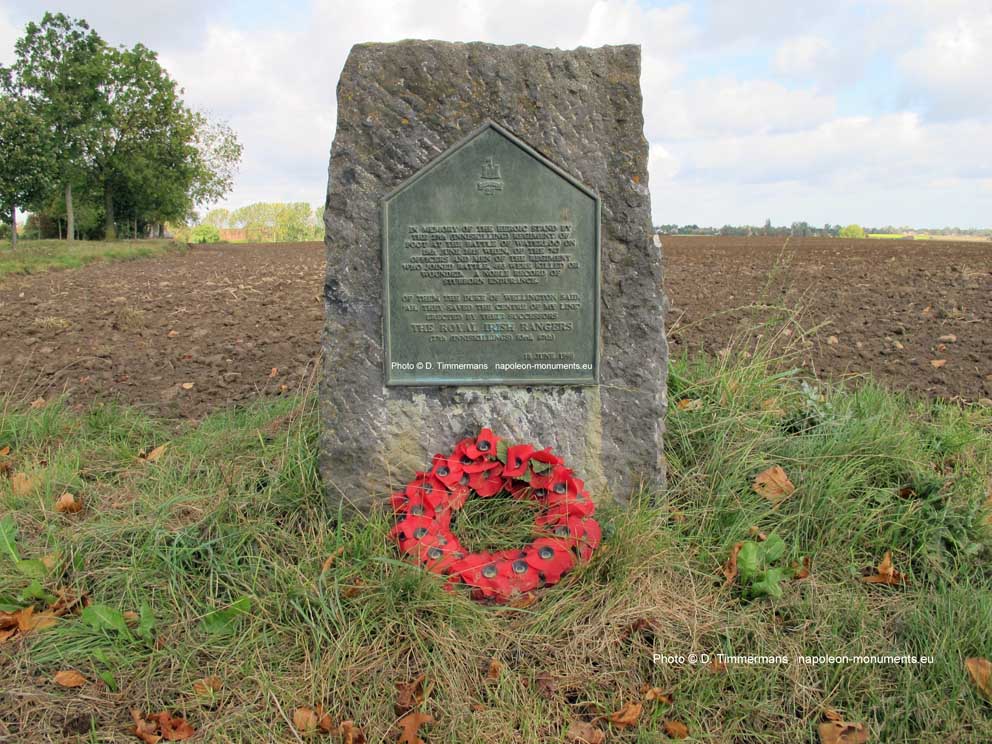
Photo taken in October 2011.
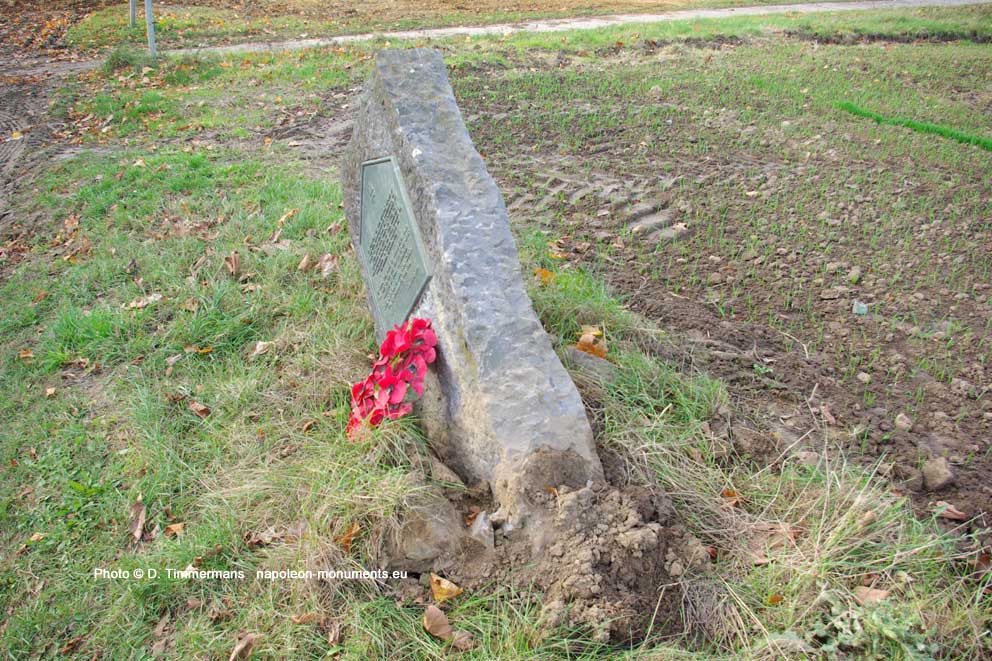
And in November 2011 !
We just had the time to rejoice about the restauration of the Picton monument,
only a few days later, the Inniskillings monument was again knocked over.
Since the road was closed and forbidden to the traffic, one can imagine that the
company working there is responsible. But will they repair the damage ?
- The stele to the 27th Foot was straightened up
on March 7, 2012 by Mr
Lucien Cécille and his team of the Waterloo Committee. Great job !
|
 |

Panorama showing the Allied left wing, along the chemin de la Croix
: to the left, the 27th Foot, to the right, the Picton monument. To the left of
the track, the Fichermont monastery, built in violation of the 1914 law of preservation
of the battlefield.
3) Stele to general Picton
TO THE GALLANT MEMORY OF LT
GENERAL SIR THOMAS PICTON
COMMANDER OF THE 5th DIVISION AND THE LEFT WING
OF THE ARMY AT THE BATTLE OF
WATERLOO
BORN 1758
DIED NEAR THIS SPOT IN THE EARLY AFTERNOON
OF 18TH JUNE
1815 LEADING HIS MAN AGAINST
COUNT DROUET D’ERLONS ADVANCE
|
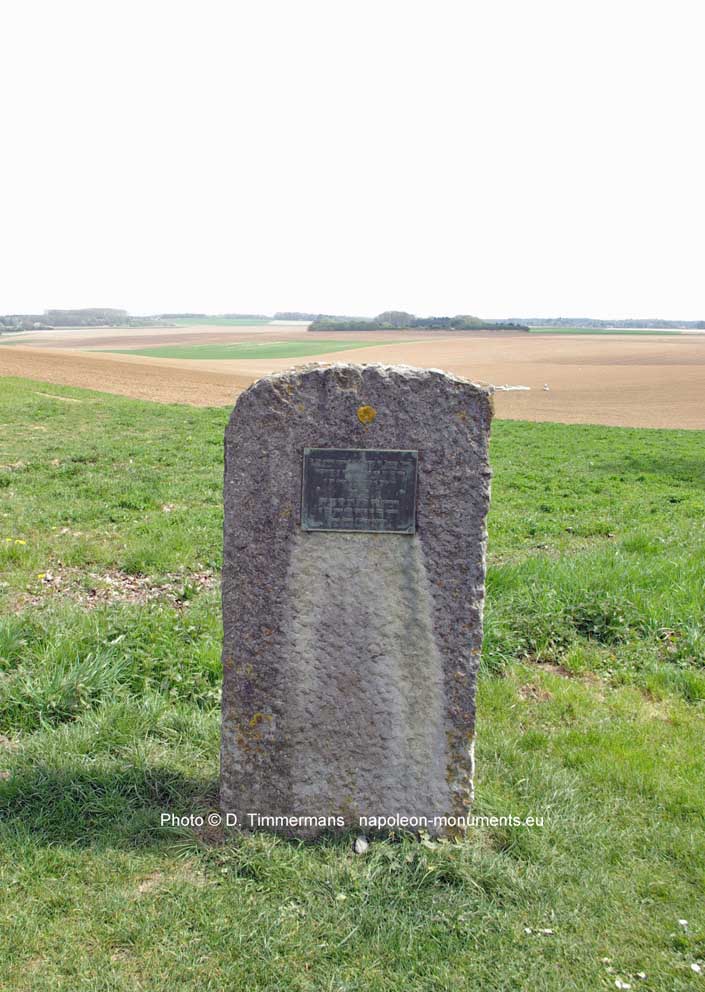 |
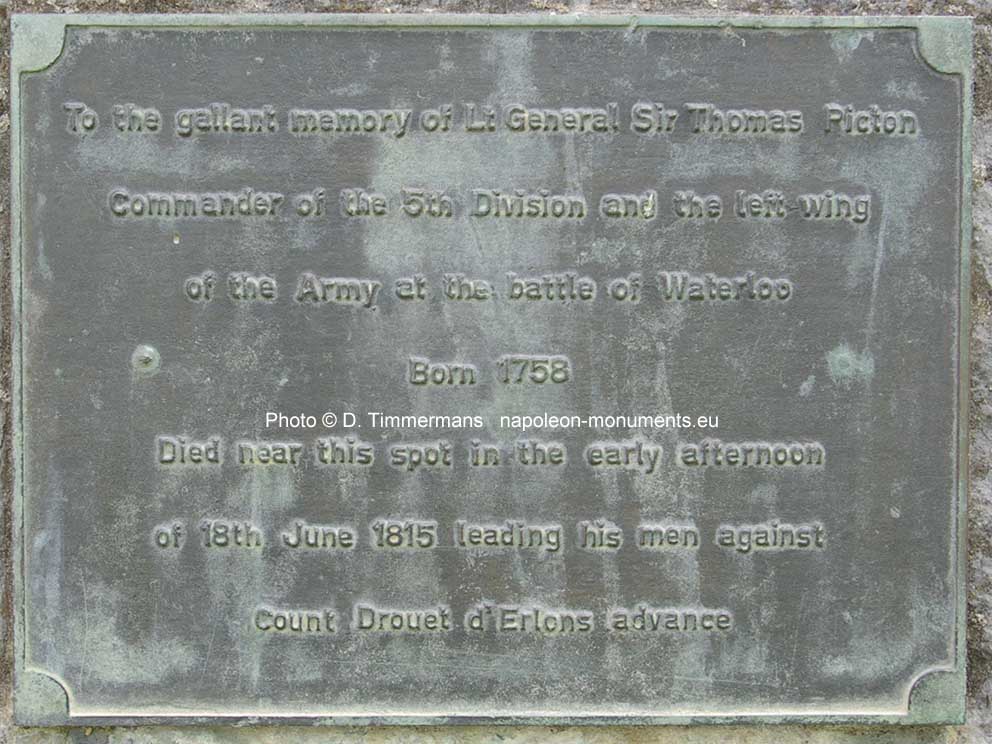 |
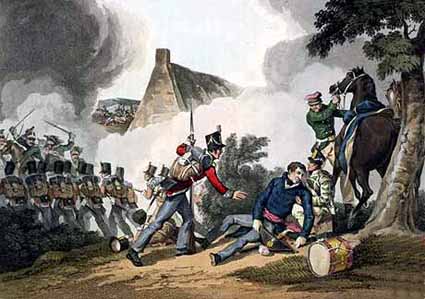
La mort de Sir Thomas Picton.
|
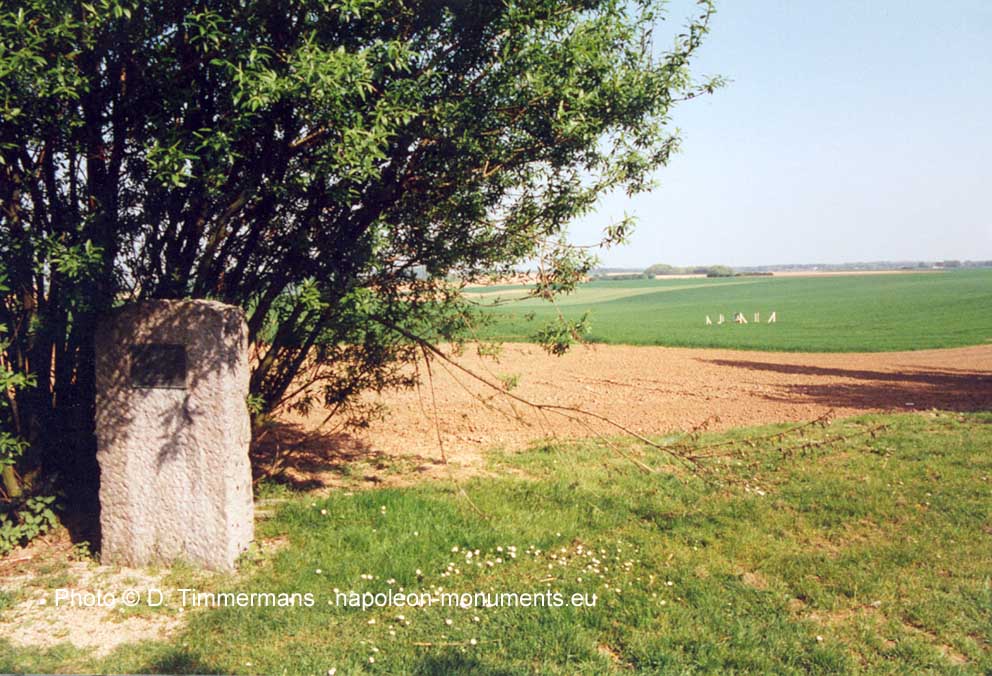 |
Originally, the stele was more inside the fields, where it was less
visible but better protected.
|

Vue panoramique du nord vers le sud à partir des champs à l'est du monument
hanovrien.
4) Gordon Monument
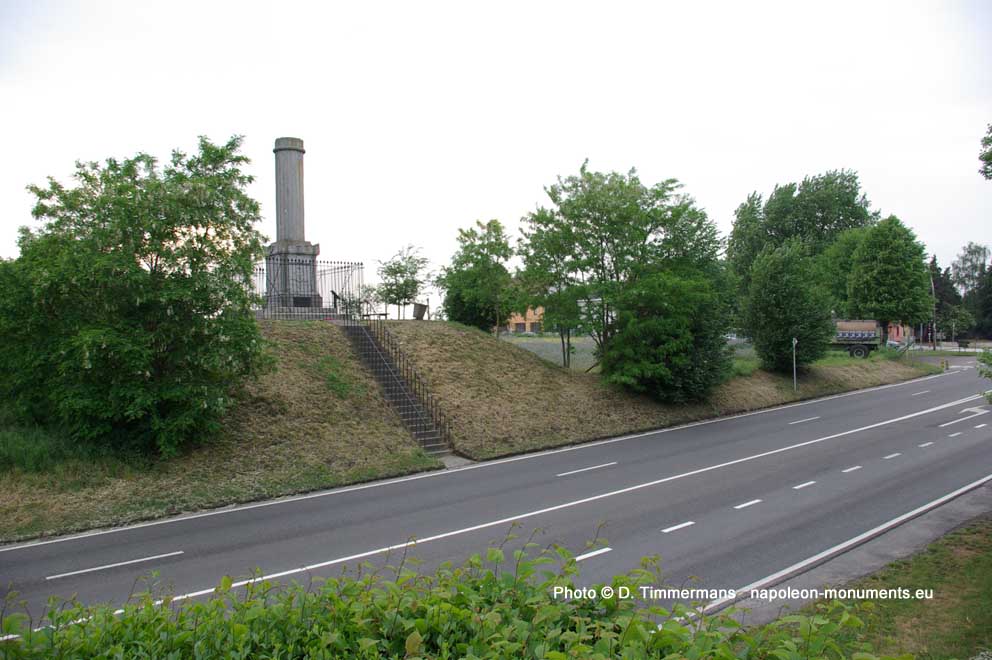
Probably one of the most symbolic and best known monuments on battlefield. It is
also one of the oldest monuments on the battlefield, after the suppression of
the individual tombs of British officers when the memorial at the Brussels
cemetery was built. This column was built in July 1817 by Gordon's family.
LtCol Sir Alexander Gordon was aide de camp to the duke of Wellington
and was
mortally wounded at his side, near the square of the 2/30th Foot at the moment
of the attack of the Middle Guard. A cannon ball took away his leg.
Sergeant-Major Wood of the 30th Foot transported him, probably first to the
Mont-Saint-Jean farm, for some first help, and after that, to the Bodenghien inn at Waterloo,
Wellington's HQ (now Wellington Museum), where he died at 3h30 in the morning of 19
June, after the amputation of his leg. Hearing of Gordon's death, Wellington
said : "Thank God, I do not know what it is to lose a battle, but certainly
nothing can be more painful than to win one with the loss of so many of one’s
friends."
Gordon was first buried at the Saint-Gilles cemetery in Brussels, but was transferred
to the Evere cemetery on the 28th May 1889, into the crypt of the British monument at the
Evere
cemetery on the 25th July 1890.*
His name is also mentioned on the plaque to the 2nd battalion
3rd Foot Guards in the Waterloo
church and on the Guards Officers Memorial in the Royal Military Chapel, Wellington
Barracks, London.
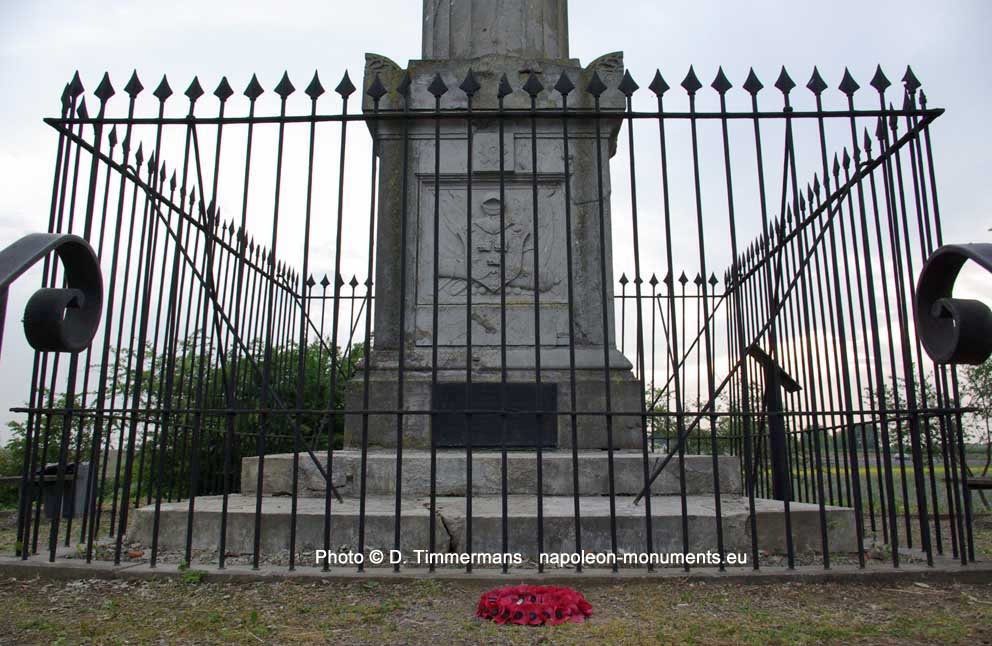
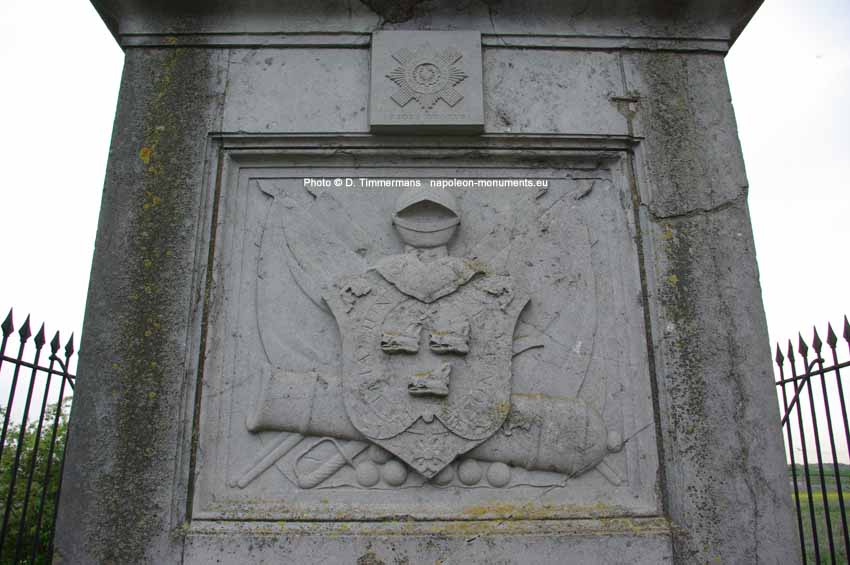
Front view. The Scots Guards stone is a more recent
addition.
TRIA JUN-CTA IN UNO
Three reunited in one
(motto of the Order of the Bath)
ICH DIEN
I serve
(Motto of the Prince of Wales and of many British regiments)
 |
TO THE MEMORY OF
THE HON. SIR ALEXANDER GORDON, K.C.B.
LT.COL SCOTS GUARDS AND AIDE DE CAMP
TO THE DUKE OF WELLINGTON
AFTER SERVING HIS COUNTRY WITH DISTINCTION
HE WAS KILLED AT THE BATTLE OF WATERLOO
18th JUNE 1815 |
To the right (north side), the English text :
At the back :
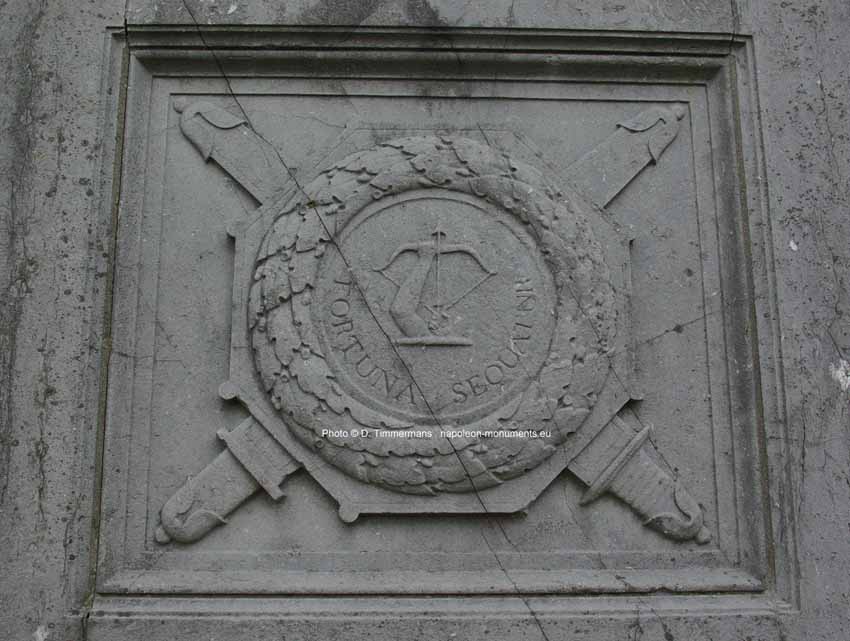
Fortuna Sequatur
May Fortune follow.
(Motto of Aberdeen : Gordon was the brother of the earl of Aberdeen)
|
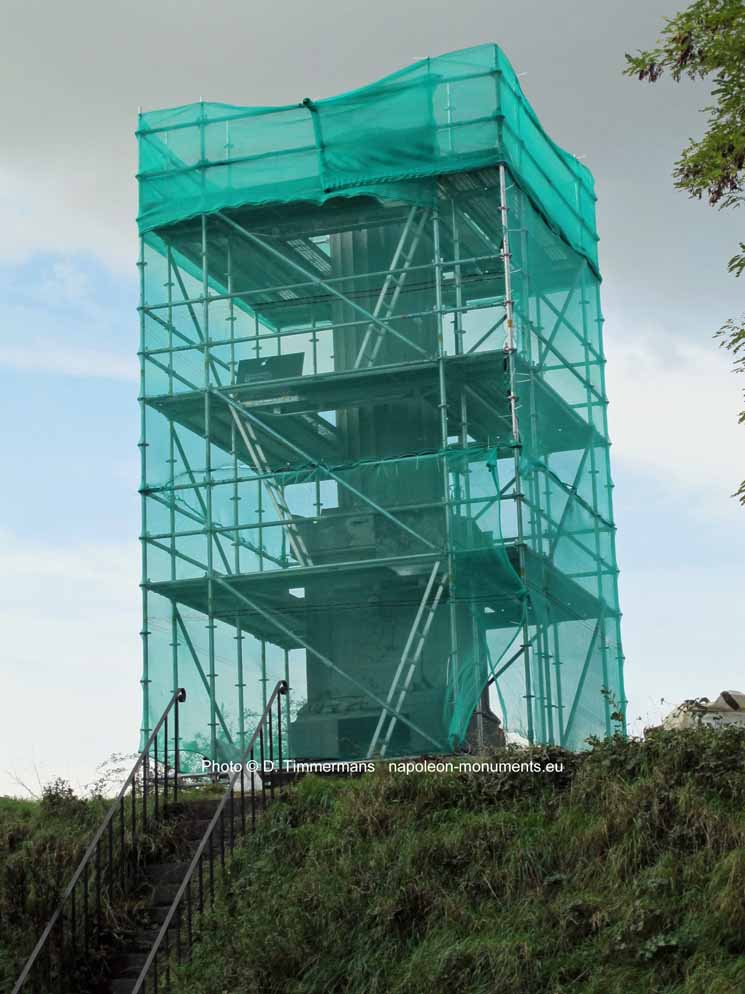
|
I might be wrong, but I think the monument has not been restored since... 1888 !
In the 19th Century, it had been done in 1837,1863, 1871 and 1888. (See
above)
The Belgian "Régie des Bâtiments" (government corporation for public
buildings) still owns the monument and is currently restoring it. The restoration
of this monument, listed since 16 August 1978,
started in October 2011.
|
The monument had been repaired in 1863 (1865 or 1868) by his brother, Admiral
John Gordon, who also had repaired his tombstone at the Saint-Gilles cemetery.
This stone can still be seen near
British monument at Evere
- The restoration works are nearing completion (April 2012).

|
 |
5) The so-called "Hanoverian Monument"
Even if they were "Germans", the members of the KGL surely
belonged to the British Army, that's why we have included this monument here. It
is located just opposite Gordon's monument, where there was probably the sandpit
so heroically defended by the 95th Rifles. This monument in the shape of a
truncated pyramid and surrounded by an iron fence
was erected in 1818 by former KGL officers to the memory of colonel Christian baron von Ompteda,
commanding the 5th Line Battalion, Colonel Karl du Plat, commanding the 4th Line
Battalion and the 36 other officers of the King's German Legion killed of
fatally wounded on the 18th June 1815.
Many sources give this place as the sandpit where so many
corpses were buried (some say 4.000). Since this monument was erected in 1818,
these corpses were probably not dug up by the companies -among these a Bavarian
one- who "visited" most Napoleonic battlefield to dig up the bones of the
victims of these battles and crush the to sell them in Great-Britain as
fertiliser for the agriculture. This disgusting practice emptied a great deal of
the common graves of the battlefields of the period.

The composition of the
2nd
Brigade K.G.L.-Col.
Baron
OMPTEDA, was as follows :
1st Light Battalion,
K.G.L. Lieut.-Col. L. Bussche.
2nd Light Battalion
Major G. Baring.
5th Line Battalion Lieut.·Col. W. B. Linsingen.
8th Line Battalion
Major Schroeder (Lieut.-Col).
To the west side :
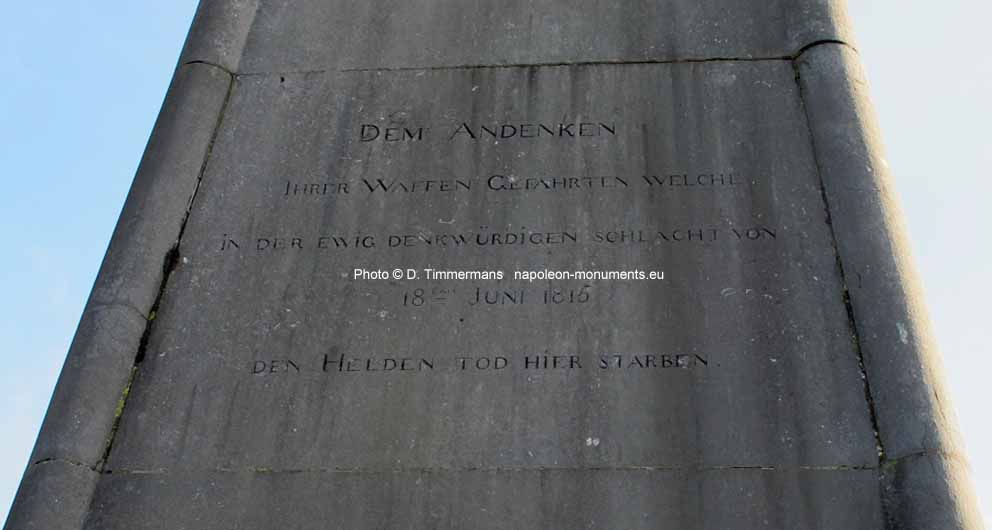 |
DEM ANDENKEN
IHRER WAFFEN GEFÄHRTEN WELCHE
IN DER EWIG DENKWÜRDIGEN SCHLACHT VON
18TEN JUNI 1815
DEN HELDEN TOD HIER STARBEN
|
On the east side, the same text in English :
|
TO THE MEMORY
OF THEIR COMPANIONS IN ARMS
WHO GLORIOUSLY FELL IN THE MEMORABLE
18TH DAY OF JUNE 1815.
this
monument
is erected by the officers of the king's
german legion |
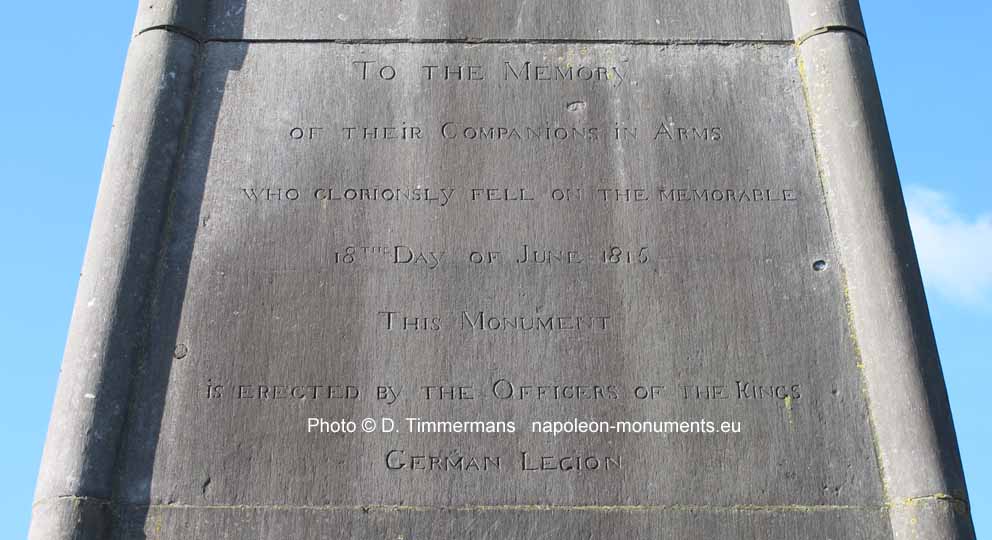 |
The second sentence is mentioned in German at the end of the
list of names, on the south side
North side :
|
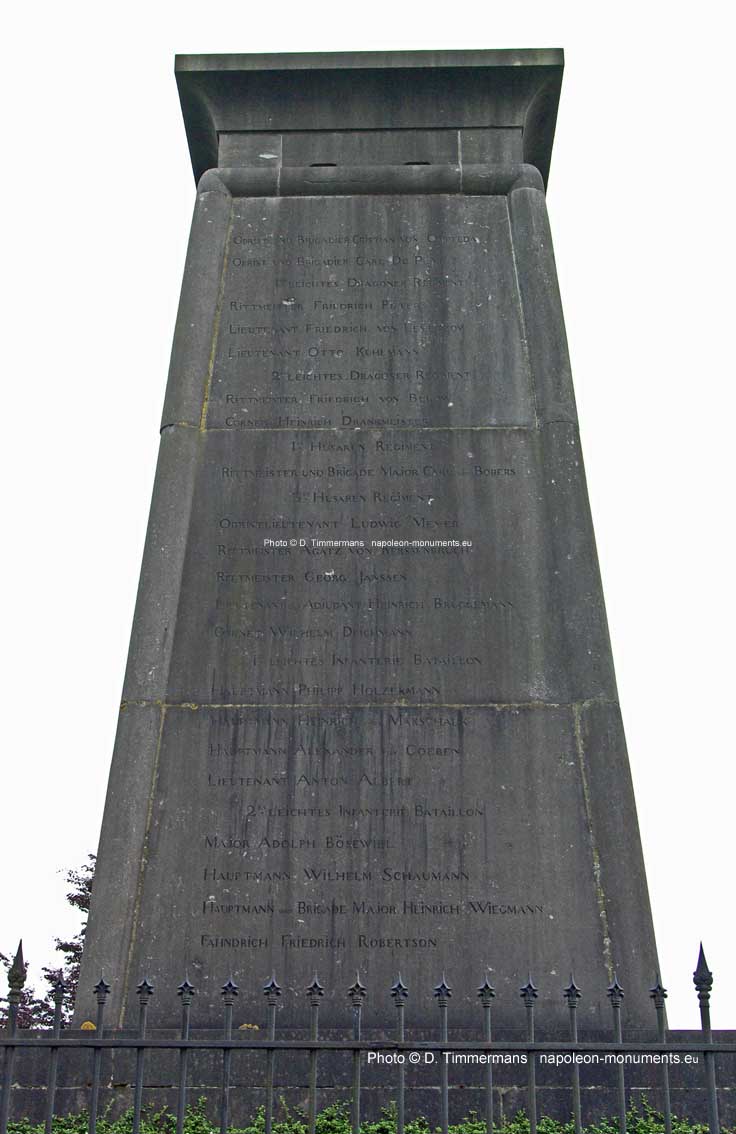
|
Obrist und Brigadier
Cristian von Ompteda
Obrist und Brigadier Carl Du Plat
1tes
Leichtes
Dragoner Regiment
Rittmeister Friedrich Peters
Lieutenant Friedrich von Levetzow
Lieutenant Otto Kuhlmann
2tes
Leichtes Dragoner Regiment
Rittmeister Friedrich von Bülow
Cornet Heinrich Drankmeister
1tes
Husaren Regiment
Rittmeister und Brigade Major Carl von Bobers
3tes
Husaren Regiment
Obristlieutenant Ludwig Meyer
Rittmeister Agatz von Kerssenbruch
Rittmeister Georg Janssen
Lieutenant und Adjudant Heinrich Bruggemann
Cornet Wilhelm Deichmann
1tes
Leichtes Infanterie Bataillon
Hauptmann Heinrich von Marschalk
Hauptmann Alexander von Goeben
Lieutenant Anton Albert
2tes
Leichtes
Infanterie Bataillon
Major Adolph Bösewiel
Hauptmann Wilhelm Schaumann
Hauptmann und Brigade Major Heinrich Wiegmann
Fähndrich Friedrich Robertson
|
We have exactly kept the spelling on the monument.
We have compared these names with the ones of the Waterloo Medal Roll.
Here are the results.
Obrist und Brigadier Cristian von Ompteda is mentioned at the 5tes
Linien Bataillon
Obrist und Brigadier Carl Du Plat is mentioned as LtCol at the 4tes
Linien Bataillon
1es Leichtes Dragoner Regiment
Colonel Dornberg was severely wounded.
Lieutenant Otto Kuhlmann, of Captain Friedrich Uslar's Troop 6.
Lieutenant Friedrich von Levetzow, of Captain Edelhorst's Troop 7
Rittmeister Friedrich Peters, of Captain Leftrew's Troop 10.
2es Leichtes Dragoner Regiment
Rittmeister Friedrich von Bülow, not mentioned as wounded.
Cornet Heinrich Drankmeister, not mentioned.
1es Husaren Regiment
Rittmeister und Brigade Major Carl von Bobers, not mentioned.
3es Husaren Regiment
None mentioned.
1stes Leichtes Infanterie Bataillon
Hauptmann Philip Hotzermann, not mentioned on the monument
Hauptmann Heinrich von Marschalk, wounded assisting Major Baring in the
defence of la Haie-Sainte.
2stes Leichtes Infanterie Bataillon
Major Adolph Bösewiel mentioned as captain, not mentioned as wounded. He was in
fact Captain Battalion Major
Hauptmann und Brigade Major Heinrich Wiegmann mentioned as Wigmann
South side :
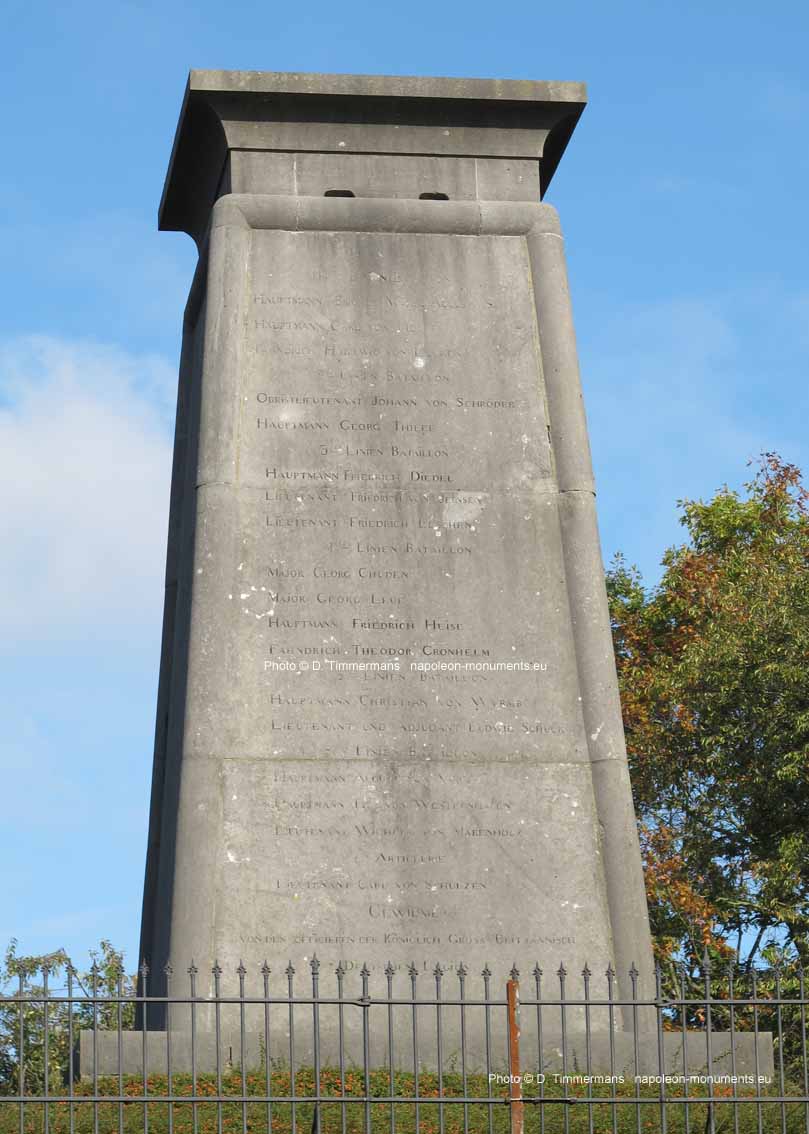 |
1tes
Linien Bataillon
Hauptmann u. Brigade Major August Saffe
Hauptmann Carl von Holle
Fähndrich Hartwig von Lucken
2tes
Linien Bataillon
Obristlieutenant Johann von Schröder
Hauptmann Georg Thilee
3tes
Linien Bataillon
Hauptmann Friederich Diedel
Lieutenant Friederich von Jeinsen
Lieutenant Friederich Leschen
4tes
Linien Bataillon
Major Georg Chuden
Major Georg Leue
Hauptmann Friederich Heise
Fähndrich Theodoor Cronhelm
5tes
Linien Bataillon
Hauptmann Christian von Wurmb
Lieutenant und Adjudant Ludwig Schuck
8tes
Linien Bataillon
Hauptmann August von Voigl
Hauptmann Fr. von Westenhagen
Lieutenant Wilhelm von Marenholz
Artillerie
Lieutenant Carl von Schulzen
Gewidmet
von den Officieren der
Königlich Gross-Britannisch
Deutschen Legion |
In the Waterloo Medal Roll:
1stes Linien Bataillon
Obristlieutenant Johann von Schröder is not mentioned.
Hauptmann Georg Thilee is mentioned as George Tilce .
3tes Linien Bataillon
Hauptmann Friederich Diedel is mentioned as Pridel.
Lieutenant Friederich von Jeinsen is mentioned as de Teinsen (died of wounds).
Lieutenant Friederich Leschen, died of wounds.
4tes Linien Bataillon
LtCol du Peat (Bat Col), died of wounds. Probably du Plat.
Major Georg Chuden, died of wounds.
Major Georg Leue is mentioned as Capitaine George Lane (died of wounds).
Hauptmann Friederich Heise, died of wounds.
5tes Linien Bataillon
Colonel baron Christian von Ompteda mentioned here.
Hauptmann Christian von Wurmb, also baron.
8tes Linien Bataillon
Hauptmann August von Voigl is mentioned as Augustus Voight.
Hauptmann Fr. von Westenhagen is mentioned as Westernhagen.
Artillery
Lieutenant Carl von Schulzen is not mentioned.
It is hard to know what source to believe. In some cases,
there are clear mistakes in the Waterloo Medal Roll,
but in other cases, it can be on the monument.
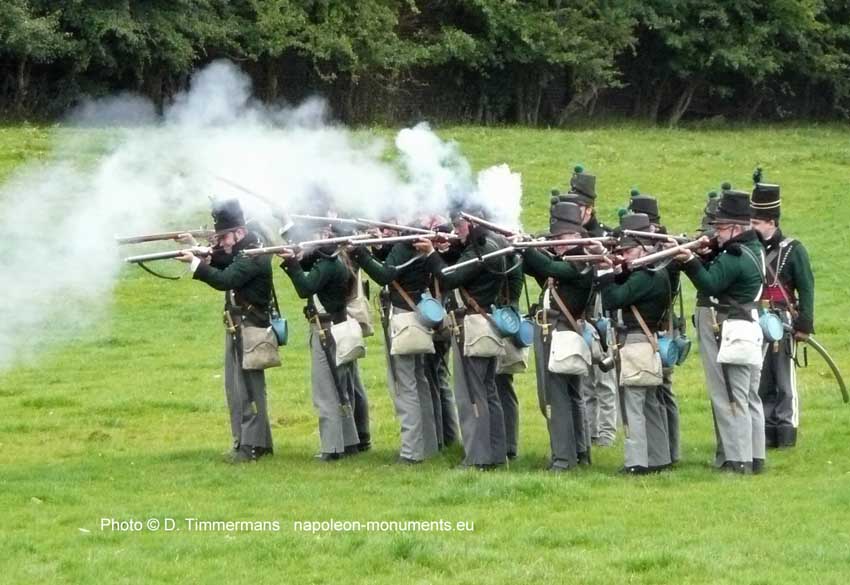
The re-enacted 2nd Lt Batt KGL (Waterloo 2009).
6) Plate to the 2nd Light Battalion, King's German
Legion and to general von Ompteda
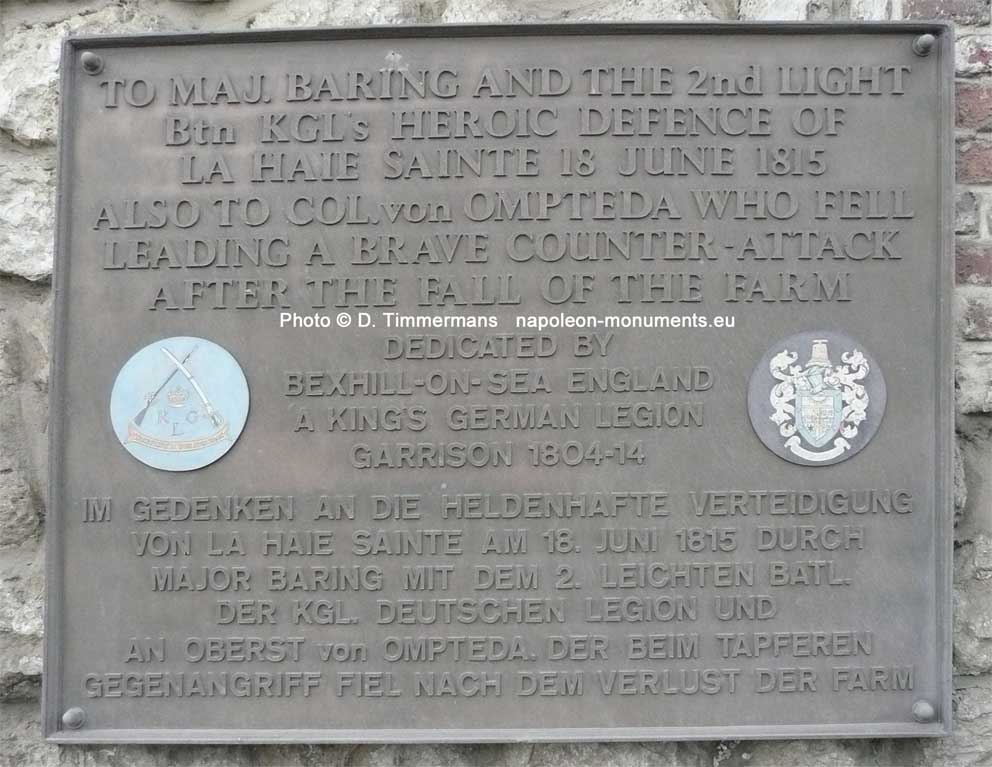 |
TO MAJ. BARING AND THE 2nd
LIGHT
Btn KGL's HEROIC DEFENCE OF
LA HAIE SAINTE 18 JUNE 1815
ALSO TO COL. VON OMPTEDA WHO FELL
LEADING A BRAVE COUNTER-ATTACK
AFTER THE FALL OF THE FARM
DEDICATED BY
BEXHILL-ON-SEA ENGLAND
A KING'S GERMAN LEGION
GARRISON 1804-14
IM GEDENKEN AN DIE HELDENHAFTE VERTEIDIGUNG
VON LA HAIE SAINTE AM 18. JUNI 1815 DURCH
MAJOR BARING MIT DEM 2. LEICHTEN BATL.
DER KGL. DEUTSCHEN LEGION UND
AN OBERST von OMPTEDA, DER BEIM TAPFEREN
GEGENANGRIFF FIEL NACH DEM VERLUST DER FARM
|
This plate was affixed in 1998.
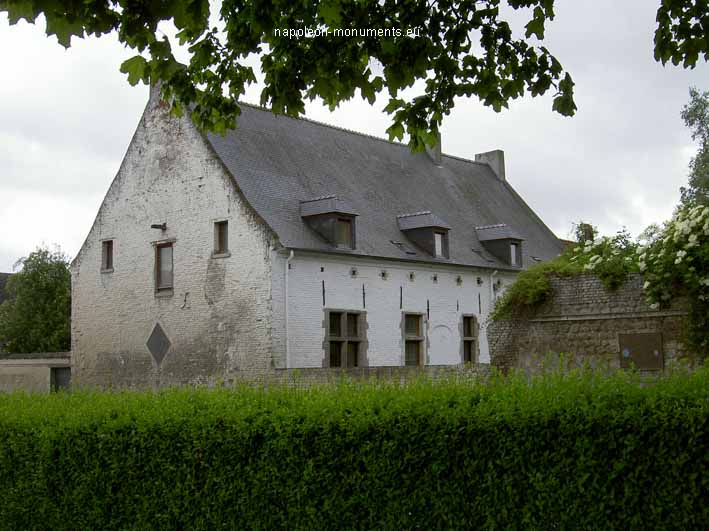
7) Plate to the fallen of the 1st and 2nd
Light Battalions and to the 5th Line Battalion of the K.G.L..
(Haie-Sainte farm)
In 1822, the Crown Prince of Hanover and the officers of the unit placed a white
marble plate on the wall of the farm. The inscription read as follows :
The Officers of the 2nd Light Battalion
King's German Legion
To the memory of their brother Officers
and friends of their Regiment who fell
in defending this farm on the 18th of June 1815.
Captain Bt Major Adolphus Bösewiel
Captain William Wiggmann
Captain Win Schaumann
Ensign Ernestus Robertson.
In 1847, this stone was replaced with an iron lozenge-shaped plate. This plate
also reminds of the sacrifice of the officers of the 1st Light Battalion and of
the 5th Line Battalion. On the other hand, the Hauptmann und Brigade Major
Heinrich Wiegmann (Wigmann) is not mentioned on the new plate.
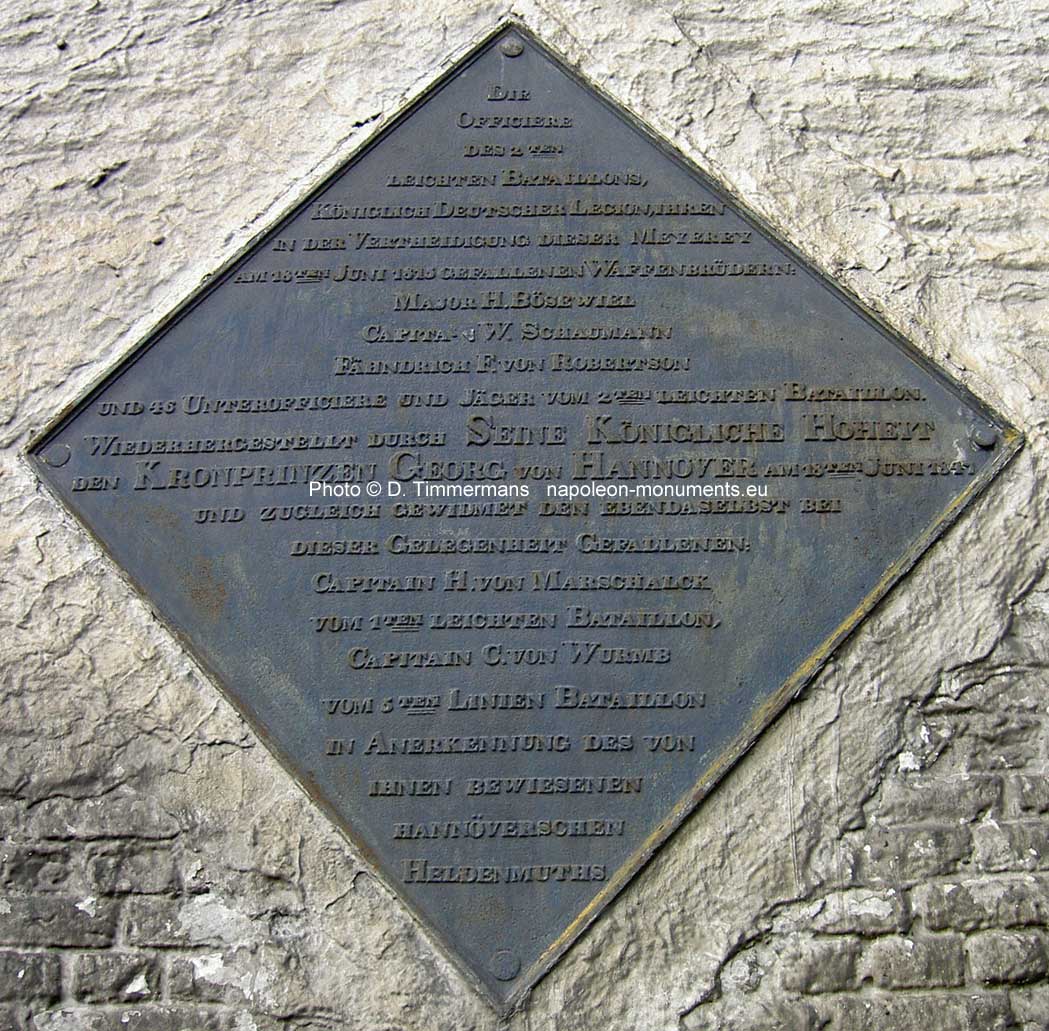 |
DIE
OFFICIERE
DES 2TEN
LEICHTEN BATAILLONS,
KÖNIGLICH DEUTSCHER LEGION, IHREN
IN DER VERTHEIDIGUNG DIESER MEYERAY
AM 18TEN JUNI 1815 GEFALLENEN WAFFENBRÜDERN:
MAJOR H. BÖSEWIEL
CAPITAIN W. SCHAUMANN
FÄHNDRICH F. von ROBERTSON
UND 46 UNTEROFFICIERE UND JÄGER VOM 2TEN LEICHTEN
BATAILLON.
WIEDERHERGESTELLT DURCH SEINE KÖNIGLICHE HOHEIT
DEN KRONPRINZEN GEORG von HANNOVER AN 18TEN JUNI 1847
UND ZUGLEICH DEWIDMET DEN EBENDASELBST BEI
DIESER GELEGENHEID GEFALLENEN:
CAPITAIN H. von MARSCHALCK
vom 1TEN LEICHTEN BATAILLON,
CAPITAIN C. von WURMB
vom 5TEN LINIEN BATAILLON
IN ANERKENNUNG DES VON
IHNEN BEWIESENEN
HANNÖVERSCHEN
HELDENMUTHS.
|
"The Officers of the 2nd Light Battalion, King's German Legion to
their brothers in arm, fallen on 18 June 1815 defending this farmstead : Major
H. Bösewiel, Captain W. Schaumann, Ensign F. von Robertson and 46 NCO and Rifles
of the 2nd Light Battalion. Restored by His Royal Highness the Crown
Prince George of Hanover on 18 June 1847. Also dedicated to Captain H. von
Marschalck, of the 1st Light Battalion and to Captain C. von
Wurmb, of the 5th Line Battalion, also fallen here. In
acknowledgement of the Hanoverian bravery they displayed."
The dead of the King's German Artillery are commemorated in
the Saint-Joseph church at Waterloo.
8) Stele marking the last position of G Troop,
Royal Horse Artillery, under command of Captain Mercer.
The stele was placed in the nineties, probably by the Waterloo
Committee. The bronze plate was stolen after 2004, but it had already been
replaces in 2008. Unfortunately, the new plate is smaller.
The stele with the original plate.
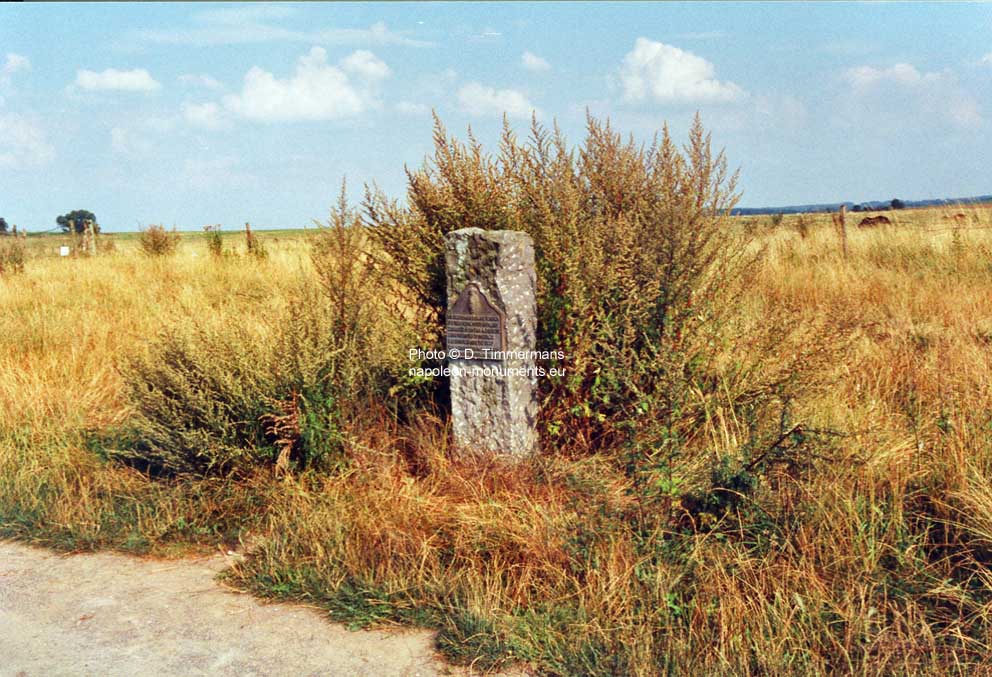
|
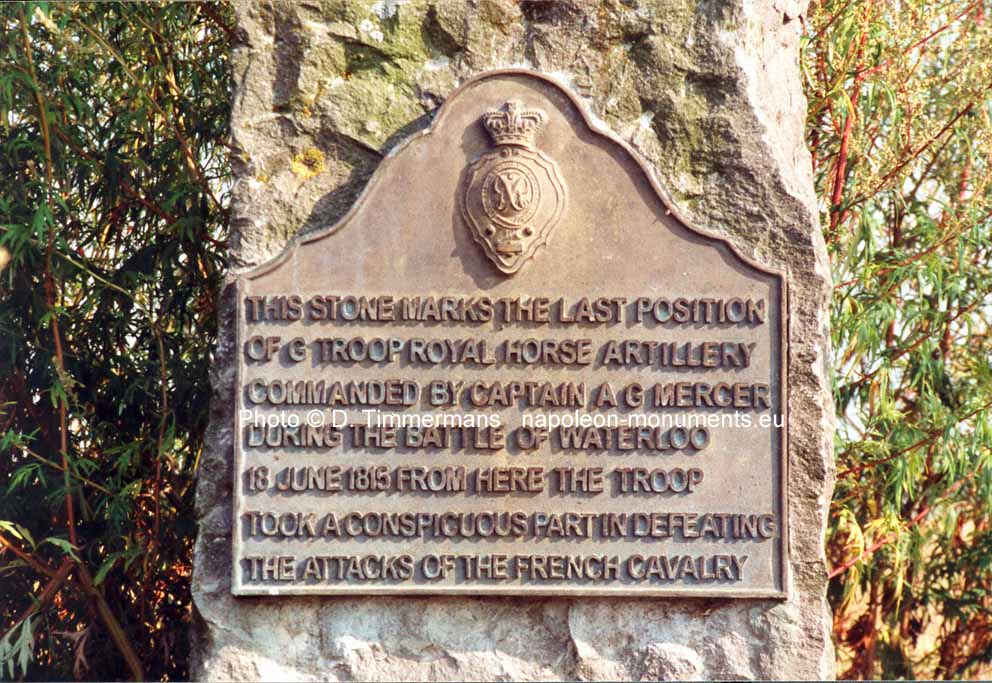 |
THIS
STONE MARKS THE LAST POSITION
OF G TROOP ROYAL HORSE ARTILLERY
COMMANDED BY CAPTAIN A.G. MERCER
DURING THE BATTLE OF WATERLOO
18 JUNE 1815 FROM HERE THE TROOP
TOOK A CONSPICUOUS PART IN DEFEATING
THE ATTACKS OF THE FRENCH CAVALRY
|
The first plate mentioned "A.G. Mercer". However, his first name was "Cavalié"
(sic).
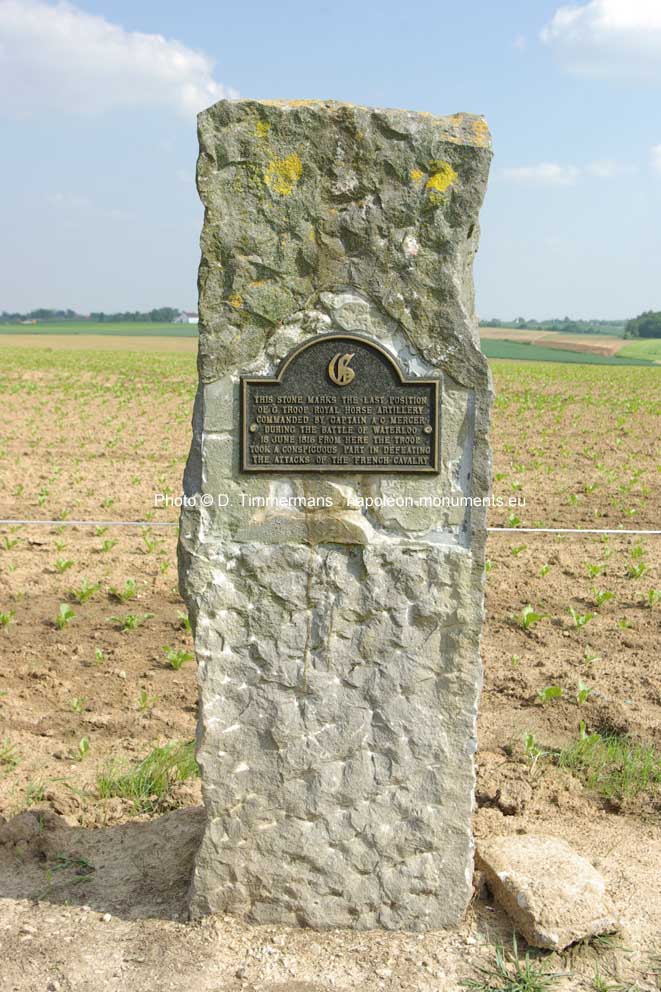
As can be seen here, the new plate is smaller than the first one, whose
shape can still be seen. Unfortunately, the R.H.A. badge was not mentioned on
the new plate.
On the other hand, the initial has now been corrected.
|
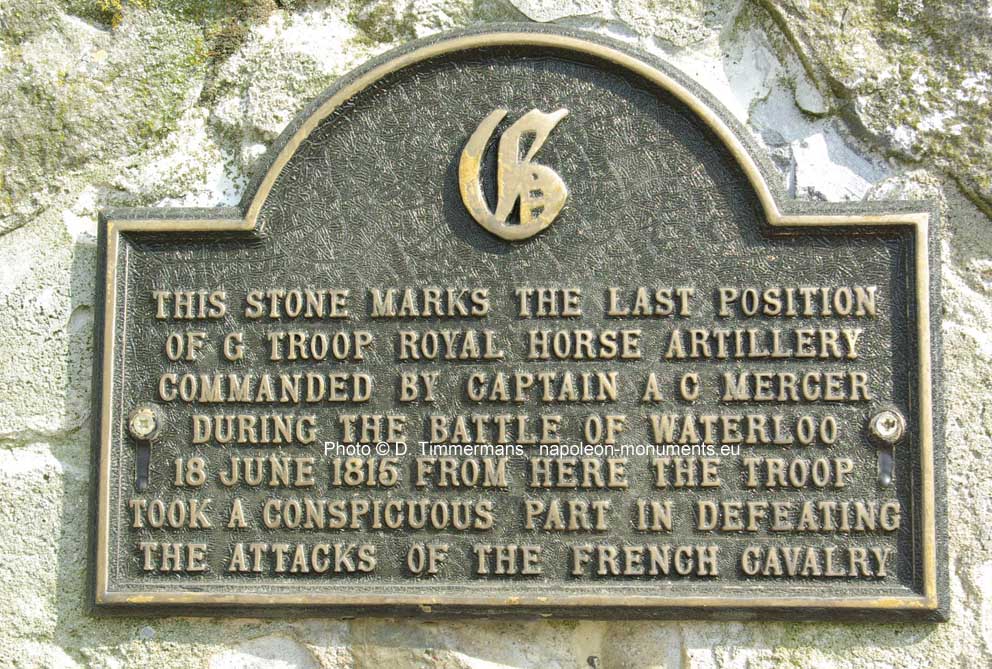 |
Don't forget to
visit the Waterloo church !
*
Du neuf à propos de la
pierre tombale du capitaine John-Lucie Blackman Cet article a paru dans la
revue de l'Association belge napoléonienne, n° 125, janvier-février 2009, pages
14 et 15.
Bibliography :
- An., The Waterloo Medal
Roll, Compiled from the Muster Rolls, The Naval and Military Press,
1992.
- Mark Adkin, The Waterloo
Companion, Aurum Press, 2001.
- Barral, Georges, Itinéraire illustré de l'épopée de Waterloo, guide
historique et militaire du champ de bataille, avec les diagrammes de l'auteur
et 60 dessins originaux d'Adolphe Hamesse. Flammarion, Paris, 1896.
- Alain CHAPPET - Roger MARTIN -
Alain PIGEARD, Le Guide Napoléon - 4000 lieux pour revivre l'épopée,
Bibliothèque Napoléonienne, Tallandier, 2005.
- Dalton, Charles, The Waterloo Roll Call, with biographical notes and
anecdotes, Eyre and Spottiswoode, London, 1904.
- Hecq, Jean, La promenade
impériale, itinéraire commenté des plaques et des stèles érigées par
l'Association Franco-Européenne de Waterloo avec le concours de la Fondation
Napoléon, A.F.E.W., s.d., Louvain-la-Neuve.
- Hofschröer,Peter, Waterloo 1815 - Wavre, Plancenoit & the race
to Paris, Pen & Sword, 2006.
- Martinien, Aristide, Tableaux
par corps et par batailles des Officiers tués et blessés pendant les guerres
de l'Empire (1805-1815), Editions militaires européennes, Paris + les
Suppléments.
- G. Speeckaert et I. Baecker,
Les 135 vestiges et monuments commémoratifs des combats de 1815 en Belgique,
Waterloo, relais de l'histoire, 1990. The is also a new 2006 edition.
- C. Van Hoorebeeck,
http://www.freepub.be/waterloo.php
- Van Neck, Léon, Waterloo met afbeeldingen
Back to the
Battle of Waterloo page
Back to the British
monuments page
Back to the homepage in English






